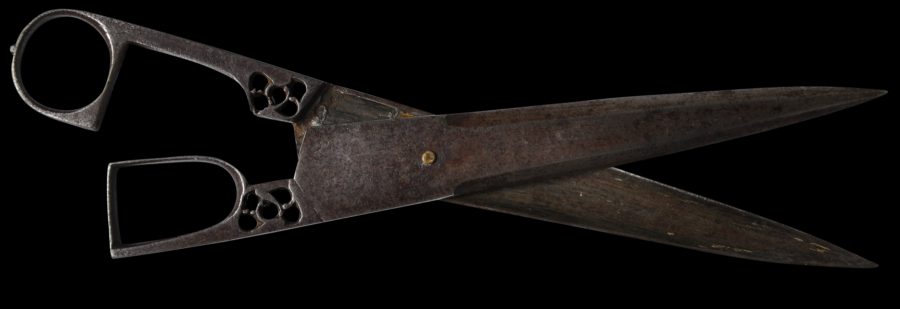Enquiry about object: 2782
Persian Calligrapher’s Pierced Steel Scissors
Iran (Persia) 18th century
length: 18cm
Provenance
The scissors were part of a collection built up over a long lifetime by an elderly collector in Worcestershire, England.
This fine pair of scissors from eighteenth century Persia is of chiselled steel. The handles are of stylised tear- and oval-shaped form with open-work. They lead to concave blades.
The handles fit into each other to give a compact form. The blades are held together by a brass rivet.
See Allen (2000, p. 94) for a related pair.
Korans, and indeed any other books or documents, had to be written by hand prior to the advent of Arabic typeset. Scissors such as these were part of the calligrapher’s tools of trade. They were used to cut paper sheets to the correct size prior to binding. Such scissors were used to cut only the finest paper. Thicker paper was cut using shears.
Iran has a long history of steel production. Steel – iron smelted with a small quantity of carbon – is much harder than iron and so is ideal for the manufacture of swords and lances. TheShah-nameh, the ‘Book of Kings’, the enormous Persian poetic epic written around 1000AD, contains the story of Jamshid who moulded iron or steel into helmets, chain-mail, swords, horse armour and the like. Later, Isfahan became an important centre for the production of small, high- quality steel items. According to Allan (2000, p. 13) there was a guild in Isfahan that comprised swordsmiths, cutlers, scissor-makers, chain-mail makers, helmet makers and Koran-case makers. Other guilds were responsible for the manufacture of other types of steel items.
Calligrapher’s scissors from nineteenth century Istanbul and elsewhere in Ottoman Turkey are relatively common. But steel calligrapher’s scissors from eighteenth century Persia or Iran, with chiselled open-work that is characteristic of Persian steelwork are much less common. The pair here are in excellent condition.




References
Allan, J.W., Persian Steel: The Tanavoli Collection, Yassavoli Publications, 2000.
Koc, A., et al, Istanbul: The City and the Sultan, Nieuwe Kerk, 2007.
McWilliams M. & D. Roxburgh, Traces of the Calligrapher: Islamic Calligraphy in Practice c. 1600-1900, Museum of Fine Arts, Houston, 2007.
Melikian-Chirvani, A.S., Le Chant du Monde: L’Art de l’Iran Safavide 1501-1736, Somogy Editions D’Art, 2007.
Savage-Smith, E., The Nasser D. Khalili Collection of Islamic Art: Science, Tools & Magic, Part Two: Mundane Worlds, The Nour Foundation, 1997.






